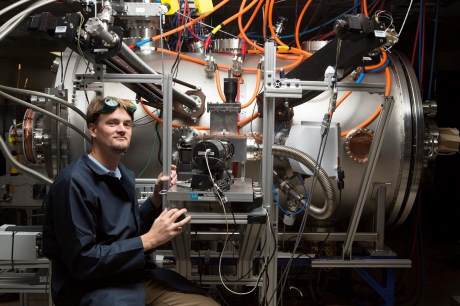Big dreams for compact fusion reactor
16 October 2014
Lockheed Martin's Skunk Works technology team has unveiled its concept for a compact fusion reactor (CFR) that it says offers many advantages over tokamak-based designs and could be developed and deployed within a decade.
 |
| Tom MacGuire with CFR's steel containment (Image: Lockheed Martin) |
Like large-scale experimental fusion projects such as ITER (the International Thermonuclear Experimental Reactor), CFR aims to harness the vast release of energy when the ions in a hydrogen plasma, created by heating hydrogen gas to very high temperatures, collide and fuse together. To achieve this, the ions in the plasma need to overcome the repulsive electrostatic forces that would normally keep them apart.
The major challenge in harnessing fusion lies in confining the superhot plasma for long enough to allow the nuclei to fuse. This can be achieved using strong magnetic fields, typically using a tokamak, which uses a series of coils to create a toroidal - or doughnut-shaped - magnetic field around the reaction chamber to confine the plasma.
Rather than using a tokamak, Skunk Works' CFR will use a series of superconducting coils to generate a magnetic field that is able to withstand temperatures of hundreds of millions of degrees and holds the plasma inside the reaction chamber itself. The design can utilise the full potential of the magnetic field's confining pressure, making it more efficient than a tokamak. This, says team leader Tom McGuire, offers a potential 90% reduction in size over previous concepts and would mean that the team could design, build and test the reactor in less than a year. "We think we can get to a prototype within five years," McGuire enthuses in a video released to describe the project.
McGuire envisages partnering with existing gas-turbine generation companies to connecting CFRs to existing gas-turbine power station infrastructure around the world. "The gas line going into that turbine? We're gonna replace that with the heat exchanger coming off our fusion reactor," he said.
Defence-focussed company Lockheed foresees the first applications of the technology being military, listing uses to power ships and even aircraft as earlier possible deployment routes ahead of use for power generation, desalination and ultimately space travel.
No matter how promising the simulations and experimental results, the CFR concept remains undemonstrated. In a press release, Lockheed said that the Skunk Works team would be "searching for partners" to help further the technology.
ITER is a global collaboration to build the largest experimental fusion facility to date, which is under construction at Cadarache in southern France. Building on projects including the Joint European Torus (JET), which became the first experiment to produce controlled fusion power in November 1991, ITER's goal is to operate at 500 MWt for at least 7 minutes. It is currently expected to enter its commissioning phase in 2019.
Skunk Works was established in 1943 as part of the US effort to rapidly develop a World War II jet fighter. It gained its unusual name from the need to protect the secret nature of its earliest projects.
Researched and written
by World Nuclear News